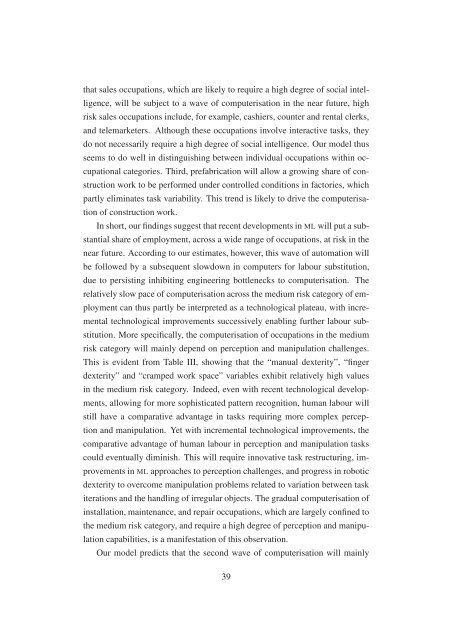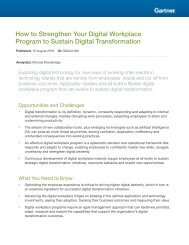The_Future_of_Employment
You also want an ePaper? Increase the reach of your titles
YUMPU automatically turns print PDFs into web optimized ePapers that Google loves.
that sales occupations, which are likely to require a high degree <strong>of</strong> social intelligence,<br />
will be subject to a wave <strong>of</strong> computerisation in the near future, high<br />
risk sales occupations include, for example, cashiers, counter and rental clerks,<br />
and telemarketers. Although these occupations involve interactive tasks, they<br />
do not necessarily require a high degree <strong>of</strong> social intelligence. Our model thus<br />
seems to do well in distinguishing between individual occupations within occupational<br />
categories. Third, prefabrication will allow a growing share <strong>of</strong> construction<br />
work to be performed under controlled conditions in factories, which<br />
partly eliminates task variability. This trend is likely to drive the computerisation<br />
<strong>of</strong> construction work.<br />
In short, our findings suggest that recent developments in ML will put a substantial<br />
share <strong>of</strong> employment, across a wide range <strong>of</strong> occupations, at risk in the<br />
near future. According to our estimates, however, this wave <strong>of</strong> automation will<br />
be followed by a subsequent slowdown in computers for labour substitution,<br />
due to persisting inhibiting engineering bottlenecks to computerisation. <strong>The</strong><br />
relatively slow pace <strong>of</strong> computerisation across the medium risk category <strong>of</strong> employment<br />
can thus partly be interpreted as a technological plateau, with incremental<br />
technological improvements successively enabling further labour substitution.<br />
More specifically, the computerisation <strong>of</strong> occupations in the medium<br />
risk category will mainly depend on perception and manipulation challenges.<br />
This is evident from Table III, showing that the “manual dexterity”, “finger<br />
dexterity” and “cramped work space” variables exhibit relatively high values<br />
in the medium risk category. Indeed, even with recent technological developments,<br />
allowing for more sophisticated pattern recognition, human labour will<br />
still have a comparative advantage in tasks requiring more complex perception<br />
and manipulation. Yet with incremental technological improvements, the<br />
comparative advantage <strong>of</strong> human labour in perception and manipulation tasks<br />
could eventually diminish. This will require innovative task restructuring, improvements<br />
in ML approaches to perception challenges, and progress in robotic<br />
dexterity to overcome manipulation problems related to variation between task<br />
iterations and the handling <strong>of</strong> irregular objects. <strong>The</strong> gradual computerisation <strong>of</strong><br />
installation, maintenance, and repair occupations, which are largely confined to<br />
the medium risk category, and require a high degree <strong>of</strong> perception and manipulation<br />
capabilities, is a manifestation <strong>of</strong> this observation.<br />
Our model predicts that the second wave <strong>of</strong> computerisation will mainly<br />
39





